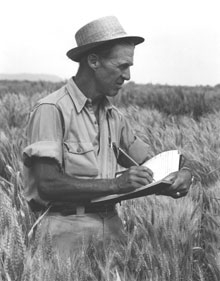🌈 Revolutions
Learn about Important Revolutions that have transformed Indian Agriculture
👉🏻 Revolution in Agriculture are significant events that lead to radical changes in the production, productivity, quality and other factors of agricultural produce.
- This could be through introduction of new technology, discoveries or new interventions.
- Following are the agricultural revolutions have occurred in India and have marked the beginning of a completely new era in the agricultural field. The agricultural revolutions helped Indian agriculture grow exponentially and created new opportunities.
Green Revolution
- The term “Green Revolution” was first used in 1968 by former USAID director William S. Gaud.
- Between 1950s and late 1960s, a set of technology interventions called
package of practiceswere under taken around the world. This resulted in increased production in parts of world. - Agriculture was trasformed from subsistance to intensive form.
- Related to Food grain production, mainly wheat and rice.
Main aspects of Green Revolution:
- Use of Seeds of high yielding varieties which were input responsive
- Use of chemical fertilizers and Pesticides
- Use of various mechanical machineries
- Use of Irrigation Facilities
- Use of the latest technological and capital inputs
- Adoption of modern scientific methods of farming
Important Points
- Agronomists bred cultivars of maize, wheat, and rice that are the generally referred to as HYVs or “high-yielding varieties”. HYVs have higher nitrogen-absorbing potential than other varieties. Since cereals that absorbed extra nitrogen would typically lodge, or fall over before harvest, semi-dwarfing genes were bred into their genomes.
- A Japanese dwarf wheat cultivar
Norin 10developed byJapaneseagronomist Gonjiro Inazuka. It was instrumental in developing Green Revolution wheat cultivars. IR8, the first widely implemented HYV rice to be developed by IRRI, was created through a cross between an Indonesian variety named “Peta” and a Chinese variety named “Dee-geo-woo-gen”

Dr. Norman Ernest Borlaugis recognized asFather of Green Revolution. He bred rust-resistant cultivars which have strong and firm stems, preventing them from falling over under extreme weather at high levels of fertilization- He won Nobel Peace Prize in 1970.
- In 1961, India was on the brink of mass famine. Norman Borlaug was invited to India by the adviser to the Indian Minister of Agriculture Dr. M. S. Swaminathan. Despite bureaucratic hurdles imposed by India’s grain monopolies, the Ford Foundation and Indian government collaborated to import wheat seed from the International Maize and Wheat Improvement Center (CIMMYT).
- The state of
Punjabwas selected by the Indian government to be the first site to try the new crops because of its reliable water supply, the presence of Indus plains which make it one of the most fertile plains on earth. - India begun its own Green Revolution program under the leadership of Dr. M.S. Swaminathan (Mankombu Sambasivan Swaminathan) in
1967-68.Dr. M.S. Swaminathanis recognised asFather of Green Revolution in India. - Green revolution was mainly restricted to
Punjab,Haryana, andWestern Uttar Pradesh. - Green revolution mainly related to
WheatandRiceproduction. - The landmark of Indian Green Revolution -
IARI, New Delhi.
Outcomes of Green Revolution
- Major achievement was observed in the yield of
Wheatform 8.5 quintals to 22.81 quintals per hectare. - Green revolution made India self-sufficient in food-grains production and made the country less dependent on imports.
| Revolution Name | Related To |
|---|---|
| White revolution | Related to Milk production 🥛 |
| Yellow revolution | Related to Oilseeds production 🌻 |
| Blue revolution | Related to Fish production 🐟 |
| Red revolution | Related to Meat/Tomato production 🍅🥩 |
| Round revolution | Related to Potato production 🥔 |
| Silver revolution | Related to Egg production/Poultry 🐔🥚 |
| Green Gold Revolution | Related to Bamboo 💚💰 |
| Silver Fiber Revolution | Related to Cotton 🧵 |
| Golden Fiber Revolution | Related to Jute 🧶 |
| Pink revolution | Related to Prawn/Onion production 🍤🧅 |
| Golden revolution | Related to Overall Horticulture/Fruit Production/Honey Production 🍇🍊🐝 |
| Gray revolution | Related to Manures and Fertilizers 💩 |
| Brown revolution | Related to Non-conventional energy source. ⚡️🌞 |
| Black revolution | Related to Bio-fuel (Jatropha) production. 🌿💨 |
| Rainbow revolution | Related to Overall growth of Agriculture Sector. 🌈 |
| Evergreen revolution | Related to Reduction in wastage of food grains, fruits and vegetables. Concept given by M.S. Swaminathan therefore known as Father of Evergreen Revolution. 🌿🍎🥦 |
👉🏻 Revolution in Agriculture are significant events that lead to radical changes in the production, productivity, quality and other factors of agricultural produce.
- This could be through introduction of new technology, discoveries or new interventions.
- Following are the agricultural revolutions have occurred in India and have marked the beginning of a completely new era in the agricultural field. The agricultural revolutions helped Indian agriculture grow exponentially and created new opportunities.
Green Revolution
- The term “Green Revolution” was first used in 1968 by former USAID director William S. Gaud.
- Between 1950s and late 1960s, a set of technology interventions called
package of practiceswere under taken around the world. This resulted in increased production in parts of …
Become Successful With AgriDots
Learn the essential skills for getting a seat in the Exam with
🦄 You are a pro member!
Only use this page if purchasing a gift or enterprise account
Plan
Rs
- Unlimited access to PRO courses
- Quizzes with hand-picked meme prizes
- Invite to private Discord chat
- Free Sticker emailed
Lifetime
Rs
1,499
once
- All PRO-tier benefits
- Single payment, lifetime access
- 4,200 bonus xp points
- Next Level
T-shirt shipped worldwide

Yo! You just found a 20% discount using 👉 EASTEREGG

High-quality fitted cotton shirt produced by Next Level Apparel